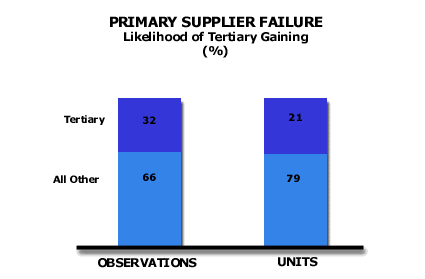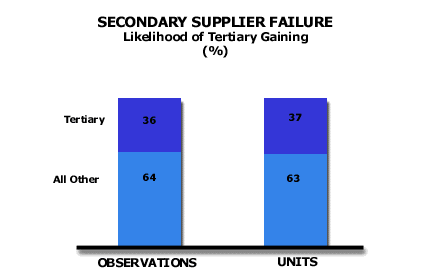Analysis 22: Likelihood of Share Gain from Lower Position When Higher Position Fails
EXHIBITS:


| HOW TO INTERPRET THE ANALYSIS: Explanation: There are two charts here. Each chart explains the probability that the Tertiary Role supplier would gain share when one of the other Role suppliers, who holds a higher Role in the customer relationship, fails. In the top exhibit, the Primary supplier has failed. The Tertiary supplier gains volume 32% of the time that the Primary supplier fails. This we can see from the “Observations” bar on the chart. Once the Primary supplier fails in this marketplace, the Tertiary supplier will gain, on average, 21% of the volume that the Primary supplier Fails Away. Secondary suppliers and all other suppliers, even those outside the customer relationship, gain the other 79% of total units. In the lower exhibit, the Secondary supplier has Failed. In the event of Secondary supplier’s failure in this industry, a Tertiary supplier will gain volume 36% of the time. This we can see from the “Observations” bar on the chart. And the Tertiary supplier, on average, gains 37% of the total volume Failed Away by the Secondary supplier. In the case of both of these exhibits, the Tertiary Role supplier has a reasonable prospect of gaining volume in the event of the Failure of a Primary or Secondary supplier ranked above them in the customer relationship.
PURPOSE: This analysis helps the company determine whether it is willing to accept low role (i.e., tertiary and lower) positions in customer relationships. These roles offer considerably less volume in the customer relationship than do the primary and secondary positions and have lower expected returns than do the larger relationships. APPROACH: The company measures the number of times, and the amount of unit volume, in a given period that went to the lower positioned supplier when a higher positioned supplier failed the relationship. The underlying assumption is that before a customer would go outside of his relationship to replace, or augment, a failing supplier, he would first examine the other incumbent suppliers in his relationship. If those suppliers are unwilling or unable to meet his needs, he would then look outside. |
| Recommended Reading |
| For a greater overall perspective on this subject, we recommend the following related items:
Analyses:
Symptoms and Implications: Symptoms developing in the market that would suggest the need for this analysis.
Perspectives: Conclusions we have reached as a result of our long-term study and observations.
|
